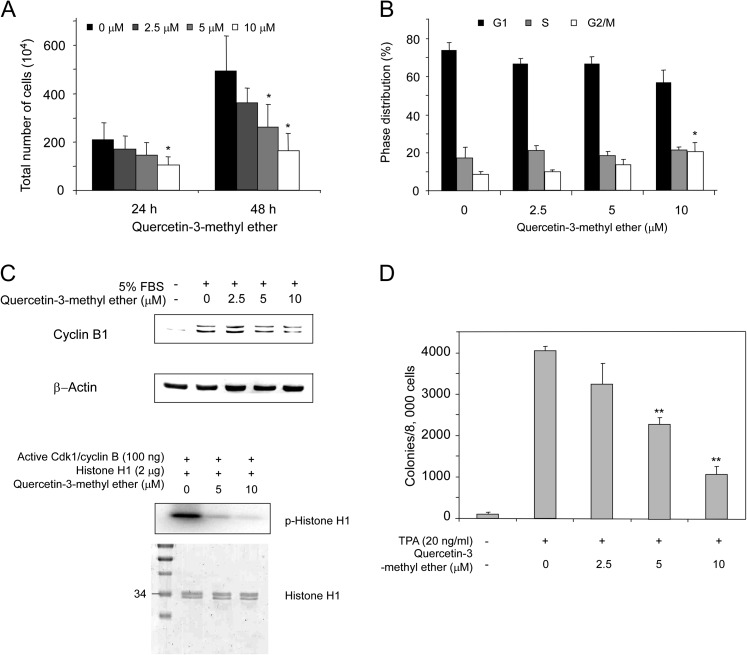Fig. 2.
Quercetin-3-methyl ether inhibits cell growth by inducing G2–M accumulation and suppresses transformation of JB6 P+ cells. (A) Quercetin-3-methyl ether inhibits cell growth. Cells were starved in serum-free medium for 24 h and then treated with quercetin-3-methyl ether (0–10 μM) or its vehicle dimethyl sulfoxide (control) in 5% FBS/EMEM for 24 or 48 h. At the end of each treatment time, cells were collected and processed for determination of total cell number. Data are shown as means ± SE. The asterisk (*) indicates a significant difference (P < 0.05) between groups treated with quercetin-3-methyl ether and the group treated with dimethyl sulfoxide. (B) Quercetin-3-methyl ether induces G2/M accumulation and suppresses cyclin B1 protein expression in JB6 P+ cells. Cells were starved in serum-free medium for 24 h and then treated with quercetin-3-methyl ether (0–10 μM) or dimethyl sulfoxide (control) for 48 h. Cell cycle analysis was performed by flow cytometry. Data are shown as means ± SE. The asterisk (*) indicates a significant difference (P < 0.05) between groups treated with quercetin-3-methyl ether and the group treated with dimethyl sulfoxide. (C) For western blot analysis, cells were treated with quercetin-3-methyl ether at the indicated concentrations for 48 h. In vitro Cdk1/cyclin B kinase assay was performed as described in Materials and methods. Coomassie blue staining (lower) shows the histone H1 protein as a loading control. Lane 1, control, which indicates that active Cdk1/cyclin B phosphorylates the histone H1 protein; lanes 2 and 3, increasing amounts of quercetin-3-methyl ether suppress Cdk1/cyclin B kinase activity. (D) Quercetin-3-methyl ether inhibits TPA-induced transformation of JB6 P+ cells. Cells were treated as described under Materials and methods and colonies were counted under a microscope with the aid of Image-Pro Plus software (v.4). Data are shown as means ± SE. The asterisks (**) indicate a significant difference (P < 0.001) between groups treated with TPA and quercetin-3-methyl ether compared with the group treated with TPA alone.

